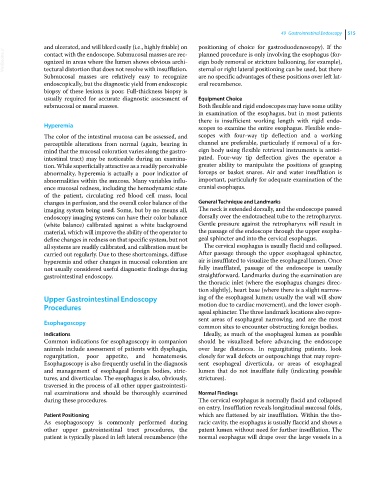Page 547 - Clinical Small Animal Internal Medicine
P. 547
49 Gastrointestinal Endoscopy 515
and ulcerated, and will bleed easily (i.e., highly friable) on positioning of choice for gastroduodenoscopy). If the
VetBooks.ir contact with the endoscope. Submucosal masses are rec- planned procedure is only involving the esophagus (for-
eign body removal or stricture ballooning, for example),
ognized in areas where the lumen shows obvious archi-
tectural distortion that does not resolve with insufflation.
are no specific advantages of these positions over left lat-
Submucosal masses are relatively easy to recognize sternal or right lateral positioning can be used, but there
endoscopically, but the diagnostic yield from endoscopic eral recumbence.
biopsy of these lesions is poor. Full‐thickness biopsy is
usually required for accurate diagnostic assessment of Equipment Choice
submucosal or mural masses. Both flexible and rigid endoscopes may have some utility
in examination of the esophagus, but in most patients
there is insufficient working length with rigid endo-
Hyperemia scopes to examine the entire esophagus. Flexible endo-
The color of the intestinal mucosa can be assessed, and scopes with four‐way tip deflection and a working
perceptible alterations from normal (again, bearing in channel are preferable, particularly if removal of a for-
mind that the mucosal coloration varies along the gastro- eign body using flexible retrieval instruments is antici-
intestinal tract) may be noticeable during an examina- pated. Four‐way tip deflection gives the operator a
tion. While superficially attractive as a readily perceivable greater ability to manipulate the positions of grasping
abnormality, hyperemia is actually a poor indicator of forceps or basket snares. Air and water insufflation is
abnormalities within the mucosa. Many variables influ- important, particularly for adequate examination of the
ence mucosal redness, including the hemodynamic state cranial esophagus.
of the patient, circulating red blood cell mass, local
changes in perfusion, and the overall color balance of the General Technique and Landmarks
imaging system being used. Some, but by no means all, The neck is extended dorsally, and the endoscope passed
endoscopy imaging systems can have their color balance dorsally over the endotracheal tube to the retropharynx.
(white balance) calibrated against a white background Gentle pressure against the retropharynx will result in
material, which will improve the ability of the operator to the passage of the endoscope through the upper esopha-
define changes in redness on that specific system, but not geal sphincter and into the cervical esophagus.
all systems are readily calibrated, and calibration must be The cervical esophagus is usually flacid and collapsed.
carried out regularly. Due to these shortcomings, diffuse After passage through the upper esophageal sphincter,
hyperemia and other changes in mucosal coloration are air is insufflated to visualize the esophageal lumen. Once
not usually considered useful diagnostic findings during fully insufflated, passage of the endoscope is usually
gastrointestinal endoscopy. straightforward. Landmarks during the examination are
the thoracic inlet (where the esophagus changes direc-
tion slightly), heart base (where there is a slight narrow-
Upper Gastrointestinal Endoscopy ing of the esophageal lumen; usually the wall will show
Procedures motion due to cardiac movement), and the lower esoph-
ageal sphincter. The three landmark locations also repre-
sent areas of esophageal narrowing, and are the most
Esophagoscopy
common sites to encounter obstructing foreign bodies.
Indications Ideally, as much of the esophageal lumen as possible
Common indications for esophagoscopy in companion should be visualized before advancing the endoscope
animals include assessment of patients with dysphagia, over large distances. In regurgitating patients, look
regurgitation, poor appetite, and hematemesis. closely for wall defects or outpouchings that may repre-
Esophagoscopy is also frequently useful in the diagnosis sent esophageal diverticula, or areas of esophageal
and management of esophageal foreign bodies, stric- lumen that do not insufflate fully (indicating possible
tures, and diverticulae. The esophagus is also, obviously, strictures).
traversed in the process of all other upper gastrointesti-
nal examinations and should be thoroughly examined Normal Findings
during these procedures. The cervical esophagus is normally flacid and collapsed
on entry. Insufflation reveals longitudinal mucosal folds,
Patient Positioning which are flattened by air insufflation. Within the tho-
As esophagoscopy is commonly performed during racic cavity, the esophagus is usually flaccid and shows a
other upper gastrointestinal tract procedures, the patent lumen without need for further insufflation. The
patient is typically placed in left lateral recumbence (the normal esophagus will drape over the large vessels in a

